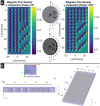Magnetic microparticle concentration and collection using a mechatronic magnetic ratcheting system
- PMID: 33600425
- PMCID: PMC7891735
- DOI: 10.1371/journal.pone.0246124
Magnetic microparticle concentration and collection using a mechatronic magnetic ratcheting system
Abstract
Magnetic ratcheting cytometry is a promising approach to separate magnetically-labeled cells and magnetic particles based on the quantity of magnetic material. We have previously reported on the ability of this technique to separate magnetically-labeled cells. Here, with a new chip design, containing high aspect ratio permalloy micropillar arrays, we demonstrate the ability of this technique to rapidly concentrate and collect superparamagnetic iron oxide particles. The platform consists of a mechatronic wheel used to generate and control a cycling external magnetic field that impinges on a "ratcheting chip." The ratcheting chip is created by electroplating a 2D array of high aspect ratio permalloy micropillars onto a glass slide, which is embedded in a thin polymer layer to create a planar surface above the micropillars. By varying magnetic field frequency and direction through wheel rotation rate and angle, we direct particle movement on chip. We explore the operating conditions for this system, identifying the effects of varying ratcheting frequency, along with time, on the dynamics and resulting concentration of these magnetic particles. We also demonstrate the ability of the system to rapidly direct the movement of superparamagnetic iron oxide particles of varying sizes. Using this technique, 2.8 μm, 500 nm, and 100 nm diameter superparamagnetic iron oxide particles, suspended within an aqueous fluid, were concentrated. We further define the ability of the system to concentrate 2.8 μm superparamagnetic iron oxide particles, present in a liquid suspension, into a small chip surface area footprint, achieving a 100-fold surface area concentration, and achieving a concentration factor greater than 200%. The achieved concentration factor of greater than 200% could be greatly increased by reducing the amount of liquid extracted at the chip outlet, which would increase the ability of achieving highly sensitive downstream analytical techniques. Magnetic ratcheting-based enrichment may be useful in isolating and concentrating subsets of magnetically-labeled cells for diagnostic automation.
Conflict of interest statement
The authors have read the journal’s policy and have the following competing interests: CM is an employee of Ferrologix, Inc. The authors would like to declare patent US10144911B2 associated with this research. This does not alter our adherence to PLOS ONE policies on sharing data and materials. There are no products in development or marketed products associated with this research.
Figures





References
-
- Parker MR. The physics of magnetic separation. Contemporary Physics. 1977;18(3):279–306.
-
- Hayes DF, Cristofanilli M, Budd GT, Ellis MJ, Stopeck A, Miller MC, et al. Circulating tumor cells at each follow-up time point during therapy of metastatic breast cancer patients predict progression-free and overall survival. Clinical Cancer Research. 2006;12(14):4218–24. 10.1158/1078-0432.CCR-05-2821 - DOI - PubMed
-
- Howard D, Bendeke M, Doyle J, Allard D, Tu PN, Hermann M, et al. A sample preparation and analysis system for identification of circulating tumor cells. Journal of Clinical Ligand Assay. 2002;25:104–10.
MeSH terms
LinkOut - more resources
Full Text Sources
Other Literature Sources

